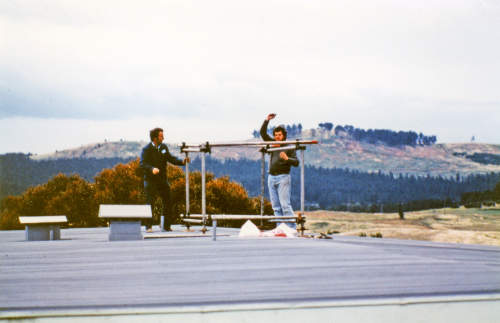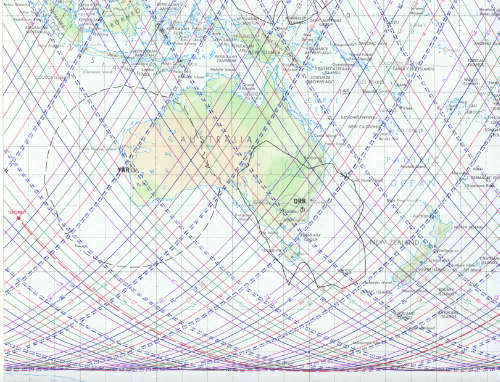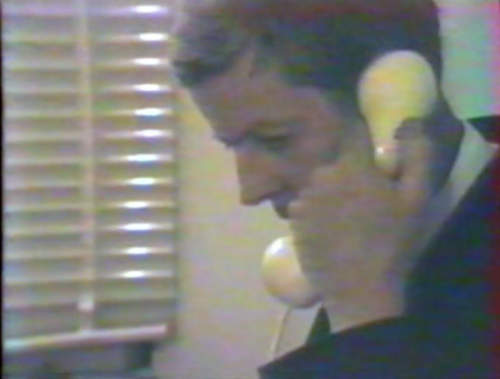STS-9 Orbit 110
VK1ORR – Amateur Radio relay between the Space Shuttle and Houston
Satellite telephony, using ordinary handheld cellular phones, will soon (2026 or 2027?) be an everyday experience. This was not always so. During the STS-9 Space Shuttle mission in 1983, Astronaut Owen Garriott used a handheld VHF transceiver to communicate with Amateur Radio Operators around the world, including King Hussein of Jordan and many others. As outlined below, Australian Amateur Radio Operators from Orroral Valley Tracking Station conducted an experiment to see if communications between a manned orbiting spacecraft and Houston Mission Control – relayed via amateur radio links – would be a viable option if ever needed. |
In his 2011 book Acquisition (pages 217-220), Philip Clark tells the story of the experimental communications circuit.
The text below is adapted, with thanks, from Philip’s book:
Another part of space history was made when licensed amateur radio operators at Orroral Valley Tracking Station (and one other amateur operator from Canberra) conducted their own private NASA-approved experiment with the orbiting Space Shuttle, Columbia in 1983.
The staff at Orroral included a number of amateur radio operators. In late 1983 they learned that another amateur from the US, astronaut Dr. Owen Garriott W5LFL, would be flying on the STS-9 flight and he would be taking a handheld VHF transceiver with him.
Owen Garriott (front left) and the rest of the crew of STS-9. NASA image S83-35017. |
The amateurs at Orroral then proposed to set up a special station at Orroral to contact Dr. Garriott on his hand-held radio onboard the Space Shuttle.
Due to untested concerns over the possibility of interference to tracking operations, permission for the station to operate from Orroral was denied by the Austrlaian Federal Department of Science and Technology, then responsible for the tracking stations in Australia.
Since the use of amateur radio on the Space Shuttle was approved by NASA, Dr. Joe Kerwin, himself a former astronaut and the NASA Representative in Australia at that time, was asked to intercede on behalf of the Orroral operators.
When Dr. Garriott learned of the interest of the Orroral amateurs, he suggested that the proposal should be a special test conducted to prove that amateur radio could be used as a viable backup communications link between the Space Shuttle and Houston. Dr. Kerwin then asked the Orroral amateurs if they would undertake this experiment. The challenge was accepted.
Given the number of amateurs who would be involved in the experiment, a request for the special call-sign of VK1ORR was made to the Australian Department of Communications and this was granted for the duration of the STS-9 mission.
The astronauts arranged with mission controllers at the Lyndon B. Johnson Space Center in Houston that one orbit of the STS-9 flight would be assigned for this historic amateur radio test. The orbit would not be revealed until after launch of STS-9 and, to further reduce the possibility of interference to the test, frequencies were arranged and kept secure by Dr. Kerwin. He only released these one hour before the scheduled time of the experiment.
Since the Orroral Tracking Station was not available, an alternative site for the amateur station had to be found. With assistance from Dr. Kerwin, and for security reasons, the NASCOM data/voice Switching Centre in the Canberra suburb of Deakin was chosen.
A room was made available at the switching centre and the amateur radio technicians installed the equipment. They had constructed special antennas and these were mounted on scaffolding erected on the roof of the building.
Dick Elliott hauls the first bag of antenna parts onto the roof of Deakin Exchange. This, and other photos of the test, courtesy Philip Clark. Scanned by Colin Mackellar. |
Feeding cables from the roof. |
Erecting scaffolding to mount the steerable antenna. |
Checking the steerable antenna. |
The main antenna used for contact with the Shuttle. |
The main antenna used for contact with the Shuttle. |
Dick Elliott and Darryl Fallow connect equipment. |
Dick Elliott and Darryl Fallow connect equipment. |
In his ‘spare time’ during the flight prior to the test orbit, Dr. Garriott had spoken with a few other amateurs on the ground, mainly in the United States.
On the evening of Monday 5th December 1983, the orbiting spacecraft Columbia flying the 110th orbit of the STS-9 mission, was passing from the north-west to the south-east of Australia, directly over Melbourne. From Canberra, it was only in view for six minutes.
The red line indicates Orbit 110 in this STS-9 groundtrack map preserved by Philip Clark. The Shuttle was travelling from top left to lower right, passing right over Melbourne. Scan: Colin Mackellar. |
For context, here is a larger portion of the STS-9 groundtrack map. Preserved by Philip Clark. Scan: Colin Mackellar. |
During the contact, the Space Shuttle was able to be patched through to the CAPCOM at Houston using the Amateur radio connected via a normal telephone line.
Joe Kerwin speaks with both Owen Garriott and Houston from the NASCOM Swithcinbg Centre in Deakin. (Frame from the video embedded below.) |
Here is a very brief part of the contact with Owen Garriott, W5LFL on board the Columbia.
After contact was established with the spacecraft and a short opening conversation, Joe Kerwin said:
“OK Owen, I'm going to turn you over to Houston. Go ahead and call Houston now.”
Garriott: “Hello Houston Capcom – Hello Houston Capcom, I expect this is Brian on the line. This is W5LFL Spacecraft Columbia, Go Ahead Brian.”
After a reply from Houston Capcom, Owen Garriott onboard Columbia responded:
“Roger, outstanding. Loud and clear. One of the best stations we have heard since we’ve been in orbit! The spacecraft attitude is just perfect. We’re looking right, right down over Melbourne at just about this moment and we just wanted to establish the fact that we could maintain a backup comm.”
Also present during this historic contact were Robert Nesen, the US ambassador to Australia, and United States Senator Jake Garn from the state of Utah.
The radio equipment of VK1ORR set up and ready to go. |
Philip Clark produced this video of the contact. |
A block diagram of VK1ORR, courtesy of Philip Clark. (Abbreviation for the telephone link to Houston, ISD = International Subscriber Dialling, the Australian equivalent to the US terminology IDDD = International Direct Distance Dialing.) |
The March 1984 issue of Electronics Today International featured an article by Philip Clark about the exercise. Cover preserved by Philip Clark. |
Those participating in the experiment – Dr. Owen Garriott W5LFL (Callsigns are those at the time of the test.) |
(October 2025.)














